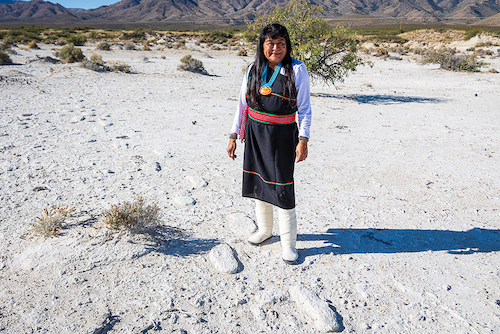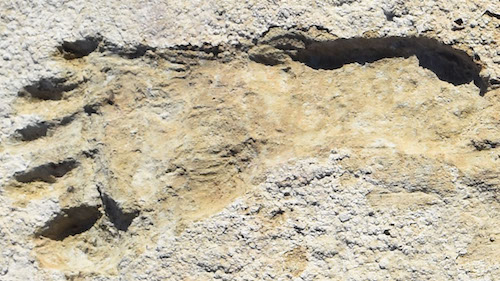Communiqué
Remarkable ancient footprints provide new evidence of humans in NOVA’s “Ice Age Footprints” – July 3 at 10 pm
< < Back toNOVA
“ICE AGE FOOTPRINTS” UNCOVERS REMARKABLE ANCIENT HUMAN FOOTPRINTS THAT COULD BE THE EARLIEST EVIDENCE OF HUMANS EVER FOUND IN NORTH AMERICA
One-hour film follows a team of scientists as they date footprints found in White Sands, New Mexico to more than 21,000 years ago
Wednesday, July 3 at 10:00 pm
This film follows archaeologists as they investigate remarkable ancient footprints found in White Sands National Park, New Mexico. For the first time, scientists date the footprints, and if confirmed, their results would indicate that humans were present in North America much earlier than archaeologists previously thought.
These footprints include tracks from 13-foot-tall mammoths, huge ground sloths, packs of dire wolves, and camels. Alongside them, though, is something even rarer—footprints of humans that have been buried for thousands of years and are gradually being exposed by wind erosion. The film uses immersive 3-D graphics to bring viewers face to face with some of the magnificent creatures that roamed North America during the last Ice Age–animals that went extinct more than 10,000 years ago–while revealing an untold story of human history on the continent.

Copyright: © Bella Falk / Passport & Pixels
Hosted by Kirk Johnson, the Sant Director of the Smithsonian National Museum of Natural History, ICE AGE FOOTPRINTS captures the work of a team of archaeologists and other scientists led by White Sands National Park Resource Program Manager David Bustos as they try to unlock the secrets of these extraordinary prints before they erode to dust. Among the questions they’re trying to answer are: Who made them? How old are they? And what can they tell us about the long history of humans in North America?
ICE AGE FOOTPRINTS brings viewers an exclusive behind-the-scenes look at some of the astonishing stories hidden in these tracks, as footprints can reveal intimate details that no bones ever could. One fascinating set of footprints excavated by forensic footprint expert Matthew Bennett tells the story of an individual making a journey and then coming back later the same day. Forensic analysis of the prints shows the person was in a hurry, and—as revealed by a set of much smaller tracks at one point along the path—they were carrying a child. Later, their track is crossed by the prints of an enormous ground sloth, which appears to rear up on its hind legs—possibly to sniff the air as it detects humans—a scene that reveals just how close humans and Ice Age animals came to one another.
“The footprints are so striking because they seem so dynamic,” said NOVA Co-Executive Producer Chris Schmidt. “It’s so easy to reach across time and picture these people and their families moving through the land and interacting with the living world around them.”
But when were the footprints made? For several decades, the mainstream archaeology community held that humans first arrived in North America about 13,000 years ago. More recently, evidence pushed that date to around 2,000 years earlier. Many scientists argued that they could not have arrived sooner, because much of the continent was covered with massive ice sheets.
Now, the White Sands footprints could be challenging that story. The film takes viewers along on a journey of discovery as scientists Jeff Pigati and Kathleen Springer use radiocarbon dating on ancient seeds found buried between the footprints and find that the footprints were made between 21,000 and 23,000 years ago. Pigati and Springer were amazed. As host Kirk Johnson says, “This is not a subtle result!”
 While the dramatic findings may be surprising for some scientists, for many Indigenous people, they are confirmation of long-held beliefs. “The tribes talk about going way back. We all talk about having been here forever,” explains archaeologist Joe Watkins, a member of the Choctaw Nation of Oklahoma, in the film. “We have the evidence. It really does put our feetprints firmly into the past here in North America. These are our relatives.”
While the dramatic findings may be surprising for some scientists, for many Indigenous people, they are confirmation of long-held beliefs. “The tribes talk about going way back. We all talk about having been here forever,” explains archaeologist Joe Watkins, a member of the Choctaw Nation of Oklahoma, in the film. “We have the evidence. It really does put our feetprints firmly into the past here in North America. These are our relatives.”
ICE AGE FOOTPRINTS also features Kim Pasqual-Charlie, Tribal Historic Preservation Board Member of the Acoma Pueblo of New Mexico, who speaks about the significance of the footprints to her community; and Edward Jolie, archeologist and citizen of the Muscogee Nation of Oklahoma, who together with Joe Watkins and archaeologist Carol Ellick, investigates some of the ancient technology that might have been used by the Ice Age inhabitants of the area to transport heavy loads, including the meat of giant mammoths.
NOVA’s cameras have been following the archaeological team’s investigations since February 2020, and in October 2021 they returned to White Sands to find out the results of the radiocarbon dating. ICE AGE FOOTPRINTS reveals the astonishing results that could transform experts’ understanding of the history of humans in North America.
“One of the reasons the dating is so important,” said NOVA Co-Executive Producer Julia Cort, “is that it puts humans deep in North America at the very height of the Ice Age. It’s another piece of evidence pointing to the epic journeys that ancient humans made at a time when the continent looked very different than it does today.”
“Seeing the footprints of ancient humans, perfectly preserved for thousands of years, is incredibly moving,” said Producer Bella Falk of Windfall Films. “There are adults and children, running, hunting, and playing—it’s a remarkable window into Ice Age life. And not only are they a wonderful connection back to the distant past, but they could also provide vital new clues to help answer the great mystery about the peopling of the Americas. It was a huge privilege to be able to follow this important study, and we are excited to share the results with NOVA viewers.”

